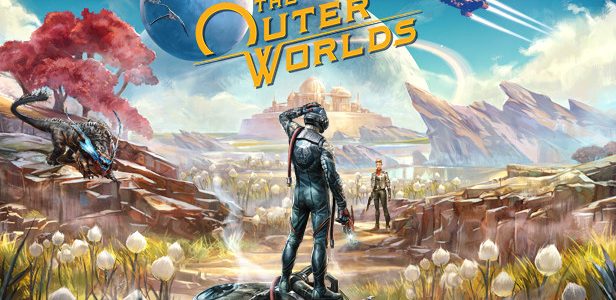Brief Breakdown:
Pros
- Unique, multifaceted skill trees alleviate traditionally restrictive RPG character systems
- An abundance of comedic and witty dialogue with a vast assortment of interesting characters
- Primary, secondary and companion questlines offer a full range of satisfying roleplay options that build to meaningful resolutions for each narrative decision
- Idiosyncratic environmental, art, and level design that creates distinct yet seamlessly interconnected worlds
Cons
- Load times aren’t ideal, though this is masked by playful and creative loading screens
- Combat can become stale as combat expression and enemy diversity is somewhat limited
- Weapons and armor adhere to a strict power curve, passively discouraging weapon and armor variety
- Crafting system is well-built but underutilized throughout the game
Full Overview:
The Outer Worlds is a sardonic and goofy Sci-Fi RPG filled with genuine banter, gorgeous backdrops, and a meaningful, rewarding narrative. It successfully iterates on historically common RPG concepts, while enrapturing the player with detailed and dynamic dialogue trees. The Outer Worlds offers vast and fulfilling narrative choices across minor conversations, extended companion quests, and every major narrative arc.
Its talent and skill trees—an RPG staple—offer an equally satisfying level of specialty, with the clever addition of granting combat value to traditionally non-combat skills (Intimidation, Engineering, or Inspiration). This creative iteration prevents roleplay-focused players from being indirectly punished for their narrative-focused skill choice (as they can be in other RPGs) while granting even more skill choices for combat-focused players to chose from.
Though varied in style, the flow of combat can become repetitive throughout the game. Companion Abilities and the Tactical Time Dilation—while flashy and dynamic—slowly begin to fade into the churn of the core combat loop. Many quests offer non-combative solutions to compensate for this, but a full-combat playthrough (perhaps rightfully so) is much less satisfying than a roleplay-focused one.
Due to the clear delineation of weapon and armor strength throughout the game, the crafting systems (scrapping, repairing, and tinkering) can feel a bit bare compared to the expansive narrative and skill systems. By utilizing a scaling tier system, The Outer Worlds grants weapon and armor upgrades at a consistent pace as you traverse Halcyon, but in doing so blemishes any old equipment that you have upgraded throughout your journey. Weapon modification provides some level of particularity in the crafting systems, but is often overshadowed by the shortcomings of tinkering and scrapping.
On a macro scale, the level design tends to off-set tightly knit interactive cities or towns with long stretches of open space. This balance doesn’t create a sense of dissonance, but rather an explorative wanting: a desire to discover the unknown in the winding and wonderous outlands of each planet. No world or location is overly difficult to traverse, but there are some unpolished gems craftily hidden in the cracks and crevasses of Halcyon.
The environmental design of The Outer Worlds is incredible, as each location feels distinct thematically, artistically, and spatially. Traversing through the ramshackle corridors of the Groundbreaker, waltzing through the prim-and-proper streets of Byzantium, and ceaselessly jumping around the tight-knit Unreliable are all distinct experiences. Each new location and level continues to balance familiarity with Sci-Fi strangeness, while blending seamlessly into the cohesive universe of The Outer Worlds.
At its core, The Outer Worlds is greater than the sum of its parts. Its comedic exploration of a capitalist dystopia is as charming as it is critical; Obsidian masterfully balances their gallows humor and emotional punches throughout The Outer Worlds, careful not to spoil one with too much of the other. Some of the core systems hint at their shallowness over time, but are deftly hidden behind the stage of its wholly immersive world. The Outer Worlds consistently provides dynamic interactions with a variety of characters, locations, and quest lines that cultivate a narrative experience that is entirely realized from beginning to end.
The Media Library is located in Chilton Hall Room 111, and you can experience the adventure of The Outer Worlds yourself in our fully equipped game space! You can check out The Outer Worlds from the Media Library in Chilton Hall Room 111, book time in our gaming space at https://esports.library.unt.edu/ or at the computers in the Media Library, and browse the entirety of our full catalogue of video games and board games at https://discover.library.unt.edu/?f%5Bcollection_facet%5D%5B%5D=Media+Library




Leave a Reply